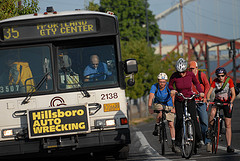On Wednesday, the TriMet Task Force on Safety and Service Excellence released its final list of recommendations. The task force was put together following a tragic incident back in April where a TriMet bus operator drove into five people in a crosswalk in downtown Portland, killing two of them.
Here’s an excerpt from the cover letter to the report written by task force Chair (and former TriMet GM) Tom Walsh,
“The tragedy of April 24, 2010, drove the direction and intensity of the task force’s work. This fateful occasion was clearly the darkest night in TriMet’s history. The focus of our recommendations is to help you migrate TriMet to the highest level of safety performance, so that such an event never happens again.”
Four recommendations stood out for me (there were 19 total):
- bringing about a culture change around safety in the agency,
- no longer using the term “accidents,”
- creating an Executive Director of Safety position,
- and a focus on “hot spots.”
The task force urged TriMet to change their culture around safety — from just another thing on the checklist, to a core value of everyone in the agency. To hasten this change, the task force recommended improved communication and engagement both internally and with the community at large.
Interestingly, the task force acknowledged the importance of language and word-choice in influencing agency culture. From the report:
TriMet should eliminate the term “accident” from its vocabulary to the extent practicable, and instead use words that are descriptive of the event in order to highlight the predictable and preventable nature of most collisions and injuries.
I’m very happy that this made it into the report. If TriMet adopts this recommendation, they could lead the way with local agencies and organizations taking a more serious stance on language. (I’d also like to see the Portland Police Bureau, PBOT, and the BTA follow suit with a similar review of language use).
An Executive Director of Safety that reports directly to the GM is another recommendation in the report. Having one person dedicated to “breaking down silos” can do wonders for communication in a bureaucracy like TriMet.
The focus on “hot spots” is perhaps the most encouraging recommendation on the list. After our story on Monday about the Transit Mall, and ongoing concerns in general about how bicycles are mixing with buses, cars, and MAX trains it, I was happy to see it specifically called out. Here’s the excerpt from the report about “hot spots”:
TriMet should use data to determine where safety “hot spots” may exist or are likely to develop over time, and take a systematic approach to evaluating and treating such “hot spots.” Based on employee comments to the Task Force, the Portland Transit Mall is a “hot spot” in need of review.
Such a review would require working with partner organizations to address the relationship
between three spheres of influence over safety on the street: (1) the operator and bus
equipment; (2) the roadway, track way and related infrastructure; and (3) other users, such
as cyclists, pedestrians and motorists.
These recommendations are a good road map to improved safety at TriMet; But they are just recommendations at this point. Hopefully in the coming weeks and months TriMet will adopt some of them.
Here are a few more links to more info about this report:
— Why didn’t the task force recommend putting cameras on buses and trains to film operators? Portland Afoot tells us why.
— Portland Afoot’s comprehensive wiki page entry on the task force.
— More coverage about the report in The Oregonian
— Read the full report via Google Docs (thanks to Portland Afoot for uploading it!).


